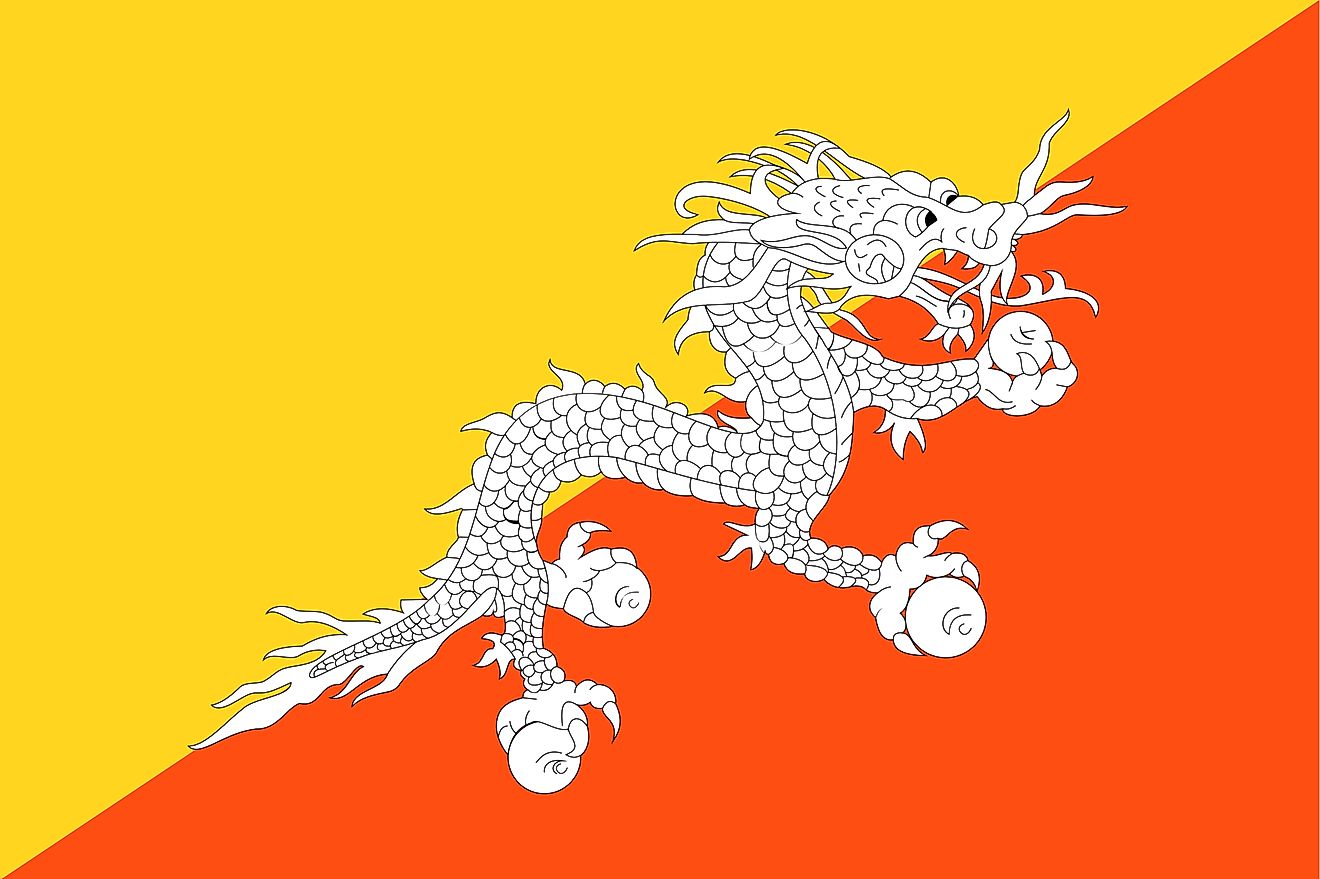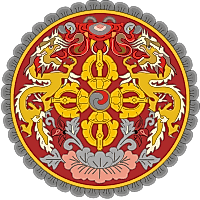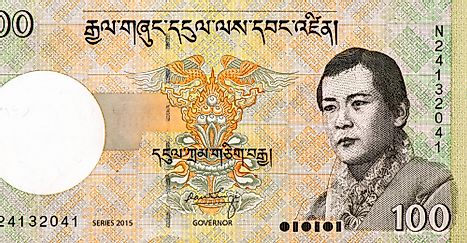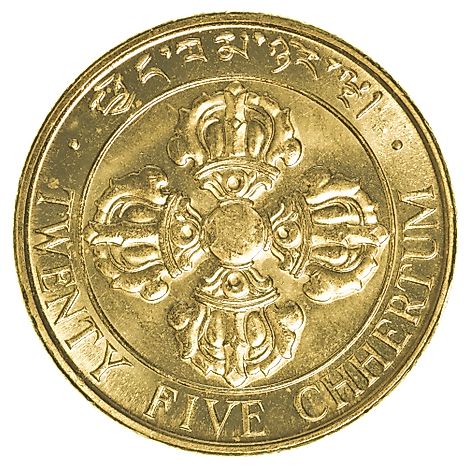Flags, Symbols & Currency of Bhutan

The Bhutan flag was officially adopted in 1969. The flag was designed by Mayum Choying Wangmo Dorji.
The national flag of Bhutan is divided diagonally from the lower hoist-side corner with the upper triangle being yellow and the lower triangle being orange. The background yellow and orange colors represent spiritual and secular powers within Bhutan. The orange color represents Buddhist traditions (mainly, the Drukpa Kagyu and Nyingma schools). The yellow color denotes the civil tradition and temporal authority as in the Druk Gyalpo – The Dragon King of Bhutan. Placed in the center of the flag and spread equally over the dividing line between the two background colors is a large black and white dragon facing away from the hoist side. The Dragon known as the Druk (Thunder Dragon) is the emblem of the nation. The dragon and its placement in the flag signify the equal importance of both civic and monastic traditions in Bhutan (Kingdom of Druk) and allude to the strength of the sacred bond between the sovereign and its people. The white color of the dragon symbolizes the purity of inner thoughts and deeds that unite all the ethnically and linguistically diverse peoples of Bhutan. The norbu (jewels) in its claws symbolize the wealth of the nation and the security and protection of its people. The snarling mouth of the dragon symbolizes the commitment of Bhutanese deities to the defense of Bhutan. The flag has a width-to-length proportion ratio of 2:3.
History of the Flag of Bhutan
The flag of Bhutan goes back to 1947 when it was designed by the orders of the reigning authorities of Bhutan. It was first displayed in 1949 at the signing of the Indo-Bhutan Treaty. This flag bore a resemblance with the current flag, except that the dragon in this flag was a pale shade of green instead of the current black and white design. The flag had a red color in the background.
A second version was introduced in 1956 for the visit of the Druk Gyalpo Jigme Dorji Wangchuk to the eastern part of Bhutan. This flag was based on the photographs of the 1949 flag and featured a white dragon (Druk) in place of the green dragon of its predecessor.
The current flag of Bhutan came into use in 1969. Subsequently, the flag was redesigned to match the measurements with the Indian Flag, which the Bhutanese believed fluttered better than their own. There were other modifications like the changing of the red-colored background to the present yellow-orange colors; the shape of the dragon was also changed to make sure that it did not face the ground.
Symbols of Bhutan
The National Coat of Arms of Bhutan

The national emblem of Bhutan is contained within a circle and features a double diamond-thunderbolt (dorje) centrally placed on a lotus flower and framed on either side by two standing dragons. The thunderbolt represents the harmony between secular and religious powers; the lotus flower symbolizes purity, and a jewel placed on top expressing sovereign power. The two dragons stand for the name of the country which they proclaim with their thunderous voice.
National Anthem
- Anthem Title: "Druk Tsenden" ("The Thunder Dragon Kingdom")
- Music Composer: Aku Tongmi
- Lyricist: Dorji Lopen Dolop Droep Namgay of Talo, Punakha
- Date of Adoption: 1953
"Druk Tsenden" ("The Thunder Dragon Kingdom") is the national anthem of Bhutan. The anthem was authored by the Venerable Dorji Lopen Dolop Droep Namgay of Talo, Punakha and translated into English by Dasho Gyaldun Thinley. The music of the anthem was composed by Aku Tongmi. The original tune was based on the folk song "Thri nyampa med pa pemai thri"("The Unchanging Lotus Throne"). The folk song has a choreography along with it and this makes the national anthem of Bhutan - the only national anthem to be based on a choreographical work. The anthem was officially adopted in 1953.
Druk Tsenden (Bhutanese)
འབྲུག་ཙན་དན་བཀོད་པའི་རྒྱལ་ཁབ་ནང་།།
དཔལ་ལུགས་གཉིས་བསྟན་སྲིད་སྐྱོང་བའི་མགོན་།།
འབྲུག་རྒྱལ་པོ་མངའ་བདག་རིན་པོ་ཆེ་།།
སྐུ་འགྱུར་མེད་བརྟན་ཅིང་ཆབ་སྲིད་འཕེལ་།།
ཆོས་སངས་རྒྱས་བསྟན་པ་དར་ཞིང་རྒྱས་།།
འབངས་བདེ་སྐྱིད་ཉི་མ་ཤར་བར་ཤོག་།།
The Thunder Dragon Kingdom
In the Kingdom of Bhutan adorned with cypress trees,
The Protector who reigns over the realm of spiritual and secular traditions,
He is the King of Bhutan, the precious sovereign.
May His being remain unchanging, and the Kingdom prosper,
May the teachings of the Enlightened One flourish,
May the sun of peace and happiness shine over all people.
The Currency of Bhutan is the Bhutanese ngultrum
The official currency of Bhutan is the Bhutanese ngultrum (Nu). The ngultrum coins and banknotes are produced by The Royal Monetary Authority of Bhutan. It is subdivided into 100 chhertum. The currency is valued at par with the Indian rupee.
The tern ngultrum is derived from Dzongkha words: ‘ngul’ for silver and ‘trum’ for money.
Coins
Various denominations were introduced in 1974 including the aluminum Ch. 5 which was square and Ch. 10 which was aluminum and scallop-shaped. Other denominations were the aluminum-bronze Ch. 20, and cupro-nickel Ch. 25. Later in 1979, a newly minted coin was presented in the forms of cupro-nickel Ch.25 and Ch. 50, bronze Ch. 5 and Ch.10, and aluminium-bronze Ch. 25. The usage of Ch. 5 and Ch. 10 has since stopped. The denominations that are presently used are Ch. 1, Ch. 20, Ch. 25, and Nu. 50.
Banknotes
The circulation of the Bhutanese notes in the denominations of Nu. 1, Nu. 5, and Nu. 10 began on June 2, 1974, by the Royal Bhutan government. In 1978, denominations of Nu. 20, Nu. 50, and Nu. 100 followed. The Royal Monetary Authority of Bhutan Act became law after legislation and approval. However, the Royal Monetary Authority did not initiate the operations until November 1, 1983, and never issued the institution family notes until 1986.
Current Series Notes
Monetary Authority introduced the latest series with different denominations ranging from Nu. 1 to Nu. 1000 in 2006.
Historical Currencies of Bhutan
The Cooch Behar mint circulated in Bhutan till 1789. Only copper and silver coins were in circulation till 1929. After this, Bhutan issued its coins known as chetrum. Modern ½ rupee silver coins were issued which was followed by the one paisa in bronze in 1931. In 1950 a nickel ½ rupee coin was released. The institution of decimalization took place in 1957, despite both Cooch Behar coins and Bhutan coins being in circulation. The first coins of the Naya Paisa denomination came into use.
The government of Bhutan improved economically in the early 1960s and in 1968 the Bank of Bhutan was created. In 1974, the official introduction of ngultrum took place with 100 chhetrum equating to 1 ngultrum. The ngultrum maintained the trade rate at par with the Indian rupee.
Before the creation of Royal Monetary Bhutan’s Authority in 1982 as central Bhutan’s Bank, the Finance Ministry introduced the first notes in the year 1974 with various denominations including Nu. 1, Nu. 5, Nu. 10, and Nu. 100. Later, Bhutan's Central Bank picked up over the issuance of banknotes from 1983 taking over the authority of the Finance Ministry.













